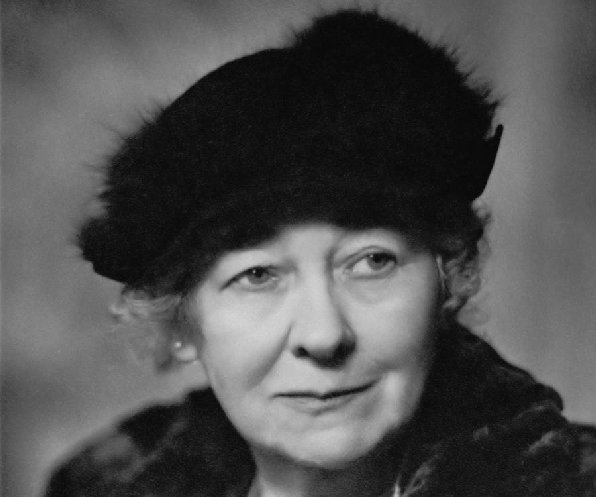

Lizzie Ansingh
My featured artist today is a Dutch lady who became a great portrait painter but may be best remembered for another type of art which I will tell you about later.

Portrait of Lizzie Ansingh by Thérèse Schwartze (1895)
Maria Elisabeth Georgina Ansingh, better known as simply Lizzie Ansingh, was born on March 13th 1875 in the Dutch town of Utrecht. She was the eldest of three daughters of the pharmacist and amateur painter, Edzard Willem Ansingh and Clara Theresia Schwartze.
Johann Georg Schwartze self portrait (1869)
Her maternal grandfather was Johann Georg Schwartze a painter from Northern Netherlands who grew up in America and her aunt who was the portrait painter Thérèse Schwartze, and it was she who gave Lizzie her first drawing lessons. For many years during her childhood, due to her mother’s poor health, Lizzy lived with her aunt Thérèse and it was this aunt who encouraged her to paint and as French impressionism was the rage around that time, Thérèse introduced Lizzy to all sorts of impressionist painters of the time. Both of them also visited many museums and art exhibitions together, which further helped Lizzy gain a perspective on art.

Theresia Ansingh by Thérèse Schwartze
Lizzie’s youngest sister Theresia Ansingh was also a painter but did not take up art, using the non-de-plume Sorella, (meaning “sister”), until she was approaching the age of 50.

Housemates by Thérèse Schwartze (c.1919)
Around 1915, Thérèse Schwartze completed a group portrait of those living together in the Ansingh/Schwartze household. The setting is a room in their house in which a table is the only furniture on show. There are five people around the table. Sitting, with her hands on her lap, is Thérèse Schwartze’s sister the sculptor, Georgine Elisabeth Schwartze. Standing at the back, dressed in black with her hands crossed, is Lizzie Ansingh’s mother, Clara Theresia Ansingh-Schwartze. In the centre, seated at the table with an open book resting on two other books is Anton Gillis Cornelis van Duyl, the journalist and editor-in-chief of the Algemeen Handelsblad, the husband of Thérèse Schwartze. On the right of the group is Lizzie’s sister Thérèse Ansingh and on the far right, standing, leaning against her sister, Maria Elisabeth Georgina (‘Lizzy’) Ansingh.

Kunstenaars or Amsterdamse Joffers: Ritsema, Surie, Osieck, Ansingh, Van den Berg, Van Regteren-Altena en Bodenheim.
In 1894, when Lizzie was nineteen years old she enrolled at the Rijksakademie van beeldende kunsten (State Academy of Fine Arts) and studied Fine Art in a separate class for female students and this helped her to further develop her artistic skills. At the Academy, she also learned about human anatomy by studying Greek and Roman statues. Whilst studying at the Academy she and a number of fellow students, Marie van Regteren Altena, Suze Bisschop-Robertson, Coba Ritsema, Ans van den Berg, Jacoba Surie, Nelly Bodenheim, Betsy Westendorp-Osieck and Jo Bauer-Stumpff, formed a group in Amsterdam called Amsterdamse Joffers. This was a group of like-minded young Dutch female painters who would meet up regularly and share their artwork and more importantly support each other on their artistic journey. Many came from wealthy and artistic families and did not depend on painting for their livelihoods. Thérèse Schwartze would often act as a mentor/facilitator at their meetings. It became a major movement in Amsterdam and opened ways for many female painters to pursue art as a full-time profession. Lizzy Ansingh joined many other art associations such as Arti et Amicitiae, kunstvereniging Sint Lucas and Pulchri Studio. Lizzy Ansingh graduated from the art academy in 1897 and by this time Thérèse Schwartze had persuaded Lizzie to make painting a full-time career. This is what she actually did.

The Source of Life by Lizzie Ansingh
As I alluded to at the start of this blog, although Lizzy Ansingh, like her aunt, painted portraits, she will be remembered for being a painter of dolls. Thérèse Schwartze, her aunt encouraged this unusual interest. Lizzy purchased an antique dollhouse from 1740s and would spend hours arranging her dolls looking for inspiration for her paintings and would often buy pieces for furnishing the dollhouse.

Flora by Lizzy Ansingh
Sadly, on the night of April 17th 1943, Lizzy’s Amsterdam studio, along with the doll-house, was severely damaged when a British bomber was shot down, destroying the Carlton Hotel and much of the Reguliersdwarsstraat alongside her studio. The fire which followed was the most devastating in Amsterdam since 1659. Fortunately Lizzie restored the dollhouse and is now part of the Museum Arnhem collection.
Child on a Carp by Lizzie Ansingh

A Doll wearing a Mantilla by Lizzie Ansingh
Lizzie wrote two children’s books, A Little Fruit Basket in 1927 and Aunt Tor has Her Birthday in 1950. She also collaborated with illustrator, Nelly Bodenhein, and published a booklet of illustrations with lines of verse. Her poetry was published in the literary magazine Maatstaf from 1956 to 1957.

Lizzy Ansingh on the occasion of her 80th birthday (13 March 1955) in her Amsterdam studio on Prinsengracht. Photo Ben van Meerendonk / AHF, IISH Collection, Amsterdam
Lizzie Ansingh never married. She died in Amsterdam on December 14th 1959 aged 84.
Information for this blog came from a number of sources including:
Arnhem aan Zee – The Doll World of Lizzie Ansing









